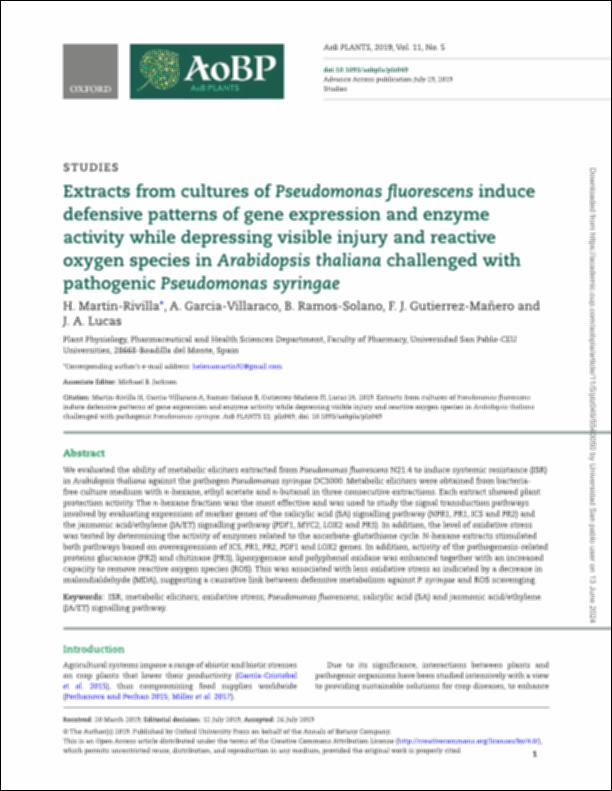Please use this identifier to cite or link to this item:
http://hdl.handle.net/10637/15941Extracts from cultures of Pseudomonas fluorescens induce defensive patterns of gene expression and enzyme activity while depressing visible injury and reactive oxygen species in Arabidopsis thaliana challenged with pathogenic Pseudomonas syringae
| Title: | Extracts from cultures of Pseudomonas fluorescens induce defensive patterns of gene expression and enzyme activity while depressing visible injury and reactive oxygen species in Arabidopsis thaliana challenged with pathogenic Pseudomonas syringae |
| Authors : | Martín Rivilla, Helena García Villaraco, Ana Ramos Solano, Beatriz Gutiérrez Mañero, Francisco Javier Lucas García, José Antonio |
| Keywords: | Metabolic elicitors; Oxidative stress; Pseudomonas fluorescens |
| Publisher: | Oxford Academic |
| Citation: | Martin-Rivilla H, Garcia-Villaraco A, Ramos-Solano B, Gutierrez-Mañero FJ, Lucas JA. 2019. Extracts from cultures of Pseudomonas fluorescens induce defensive patterns of gene expression and enzyme activity while depressing visible injury and reactive oxygen species in Arabidopsis thaliana challenged with pathogenic Pseudomonas syringae. AoB PLANTS 11: plz049; doi: 10.1093/aobpla/plz049 |
| Abstract: | We evaluated the ability of metabolic elicitors extracted from Pseudomonas fluorescens N21.4 to induce systemic resistance (ISR) in Arabidopsis thaliana against the pathogen Pseudomonas syringae DC3000. Metabolic elicitors were obtained from bacteria free culture medium with n-hexane, ethyl acetate and n-butanol in three consecutive extractions. Each extract showed plant protection activity. The n-hexane fraction was the most effective and was used to study the signal transduction pathways involved by evaluating expression of marker genes of the salicylic acid (SA) signalling pathway (NPR1, PR1, ICS and PR2) and the jasmonic acid/ethylene (JA/ET) signalling pathway (PDF1, MYC2, LOX2 and PR3). In addition, the level of oxidative stress was tested by determining the activity of enzymes related to the ascorbate-glutathione cycle. N-hexane extracts stimulated both pathways based on overexpression of ICS, PR1, PR2, PDF1 and LOX2 genes. In addition, activity of the pathogenesis-related proteins glucanase (PR2) and chitinase (PR3), lipoxygenase and polyphenol oxidase was enhanced together with an increased capacity to remove reactive oxygen species (ROS). This was associated with less oxidative stress as indicated by a decrease in malondialdehyde (MDA), suggesting a causative link between defensive metabolism against P. syringae and ROS scavenging. |
| URI: | http://hdl.handle.net/10637/15941 |
| Rights : | http://creativecommons.org/licenses/by-nc-nd/4.0/deed.es Open Access |
| ISSN: | 2041-2851 |
| Issue Date: | Jul-2019 |
| Center : | Universidad San Pablo-CEU |
| Appears in Collections: | Facultad de Farmacia |
Items in DSpace are protected by copyright, with all rights reserved, unless otherwise indicated.


